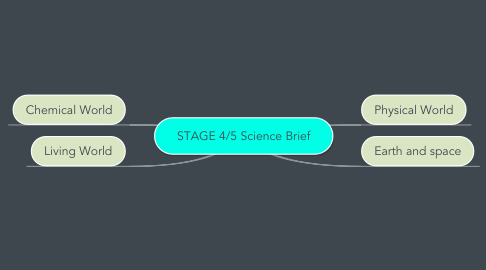
1. Chemical World
1.1. Composition and behaviour of matter.
1.1.1. CW1 - Particle model of matter - States of matter - Changes of state, including evaporation, condensation, melting and freezing
1.1.1.1. CW1 - Structure of atoms, including development of models - Radioactivity, including its uses
1.1.2. CW2 - Properties of matter, including their uses - Classification of matter - elements, compounds, mixtures
1.1.2.1. CW2 - Understanding the Periodic Table
1.1.3. CW3 - Separation of matter
1.1.4. CW4 - Chemical change and reactions - Production and uses of materials - Examples of natural chemical changes
1.1.4.1. CW3 - Chemical reactions and the rearrangement of atoms - Chemical reactions in non-living systems (combustion, acids/metals/carbonates, corrosion, precipitation, neutralisation, decomposition) - Chemical reactions in living systems (respiration, photosynthesis, digestion) - Writing chemical equations
1.1.4.2. CW4 - Energy changes in chemical reactions (endothermic, exothermis) - Rates of reactions, including temperature and catalysts - Careers in science and technology
2. Living World
2.1. The structure and function of living things (cells to ecosystems).
2.1.1. LW1 - Classification of organisms
2.1.2. LW2 - Cells
2.1.3. LW3 - Cells to Organisms - Cellular specialisation and biological functions
2.1.3.1. LW1 - Sensing and responding to stimuli - Homeostasis and coordinating internal functions - Diseases (infectious and non-infectious)
2.1.3.2. LW3 - Genetics and inheritance
2.1.4. LW4 - Changes in our understanding of human health and other issues, including technology and other criteria
2.1.5. LW5 - Ecosystems - Conservation - Human impacts
2.1.5.1. LW2 - Ecosystems - cycling of matter and energy - Conservation and sustainable use of ecosystems
2.1.5.2. LW4 - Evolution
3. Physical World
3.1. Understanding the nature of forces and motion, and matter and energy
3.1.1. PW1 - Forces and motion
3.1.1.1. PW2 - Motion
3.1.2. PW2 - Non-contact forces (electricity, magnetism, gravitation)
3.1.2.1. PW3 - Electricity
3.1.3. PW3 - Energy - forms and transformation
3.1.3.1. PW1 - Modelling energy transfer - waves and particles
3.1.4. PW4 - Role of technology in energy transformations
3.1.4.1. PW4 - Energy transfers, transformations and conservation
4. Earth and space
4.1. Earth's dynamic structure and its place in the cosmos
4.1.1. ES1 - Rock cycle
4.1.1.1. ES2 - Geological activity and continental movements.
4.1.2. ES2 - Relative positions of Sun, Earth & moon. - Structure of the solar system. - Development of models of the solar system (history and technology)
4.1.2.1. ES1 - Origins of the Universe - Features of stars, solar systems and galaxies - Gravity
4.1.3. ES3 - Renewable and non-renewable resources. - Use and management of resources
4.1.3.1. ES3 - Structures and interactions of the hydrosphere, atmosphere, biosphere and the lithosphere - Human activities and global systems
4.1.4. ES4 - Water cycle and its management
